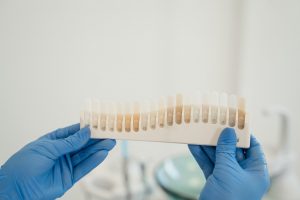 Dental crowns were made of various metals for generations, making them durable and effective. However, they weren’t aesthetically pleasing. All-ceramic materials have replaced metal crowns because they look like real teeth. Your dentist will customize your crown to the color, size, and shape of your teeth to blend in. This requires a specific art and science to ensure your crown matches your enamel. Here’s the process your dentist will use to ensure the best results.
Dental crowns were made of various metals for generations, making them durable and effective. However, they weren’t aesthetically pleasing. All-ceramic materials have replaced metal crowns because they look like real teeth. Your dentist will customize your crown to the color, size, and shape of your teeth to blend in. This requires a specific art and science to ensure your crown matches your enamel. Here’s the process your dentist will use to ensure the best results.
The Art of Color-Matching Crowns
Your dentist won’t just pick a color off a chart to create your restoration. Teeth come in many shades and tones, as well as hues, chromas, and values. Teeth can range from yellow to off-white, and they change color from various issues, like lighting, lipstick, and clothing. Therefore, your dentist will advise you to:
- Skip wearing dark lipstick or makeup, which can interfere with the color contrast.
- Avoid bright-colored clothing.
- Wear gray because it is neutral.
A shade guide is the most traditional method of color-matching restorations, which is a small plastic or metal card with fake teeth arranged in an order of the natural colors of teeth. It’s held next to your teeth under natural or fluorescent lighting to find the color that most closely mimics your enamel.
Your dentist will drape a bib over your clothing to avoid any color discrepancies created by your outfit. They will only look at your teeth and the shade guide for a few seconds before looking away to “reset” their eyes.
Determining the perfect color takes experience and a unique skill set to achieve the best results.
The Science of Color-Matching Crowns
Although the traditional method is effective, it does have some room for error. Technological advancements can provide accurate results using a small electronic device. A spectrometer has sensors that interpret the colors of teeth to note the shade. The information is sent to the dental lab, along with the impression of your mouth. The lab will craft your restoration to the exact specifications provided by your dentist.
After the dental lab sends your crown back to your dentist, you’ll return to have your temporary restoration removed. They’ll bond your permanent crown to your tooth, and only a trained dental professional will be able to tell it is there.
Choosing a color for a crown doesn’t happen by chance. It requires art and science to create natural-looking results. Although your restoration won’t contain any metals, it will be strong and durable to last for 10 years or more with the correct aftercare, like brushing and flossing.
About Dr. John Young
Dr. Young earned his dental degree at the University of Washington and has regularly continued his training to provide the most up-to-date services. He is affiliated with many professional organizations, including the Washington Dental Association. Request an appointment through his website or call (360) 383-5185.

